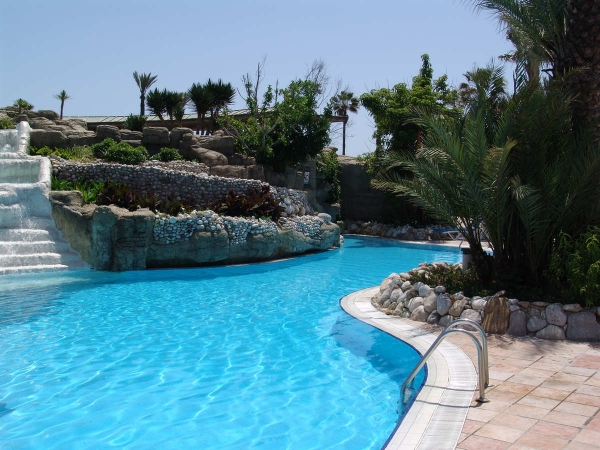No matter if you rely on a service company to take care of your pool, you still need to do a few things on your own to ensure your pool stays in good condition for years.
Skim Debris and Clean out Baskets
Skimming the pool’s surface by hand every few days is one of the fastest and easiest ways to keep your pool clean. Floating debris will eventually sink, becoming harder to remove. Use a long-handled net called a hand skimmer or leaf skimmer to remove leaves, bugs and other unwanted items. Skimming significantly increases the efficiency of the pool’s circulation system and lowers the amount of chlorine you’ll need to add to your pool. Cleaning out strainer baskets at least once a week also helps circulation and lowers chlorine demands.
Locate strainer baskets attached to the side of aboveground pools and in the pool deck of inground pools. Simply remove the plastic basket and shake it out; spraying the inside with a hose can help dislodge stubborn objects.
Vacuum the Pool and Brush the Walls and Tiles
A pool should be vacuumed every week to keep water clear and reduce the amount of chemicals you need to add to it. There are many types of pool vacuums. If you have a manual design, work it back and forth all over the surface of the pool like you would if vacuuming carpet. It’s good form to slightly overlap each stroke. Check the filter each time you vacuum, and clean it if necessary.
But vacuuming isn’t the only maintenance that should be done once a week. Brushing the walls and tile helps minimise algae buildup and calcium deposits so they don’t fester and become larger problems. The material your pool walls are made of dictates what kind of cleaning tools you should use. Select a stiff brush for plaster-lined concrete pools and a softer brush for vinyl or fiberglass walls. For tiles, use a soft brush to prevent scratching or degradation of grout. A pumice stone, putty knife or a half-and-half mixture of water and muriatic acid can also work well.
Clean the Pool Filter
There are three kinds of pool filters: cartridge, sand and diatomaceous earth. While there are different maintenance procedures for each type, all require periodic cleaning depending on the type of filter and how often a pool is used. Cleaning the filter more often than recommended can actually hinder the filtration process. A clean filter is less efficient than one with a mild amount of dirt in it because the dirt helps trap other particles, which removes debris from the water. However, you don’t want to let the filter get too dirty. A sign that it’s time to clean is an increase in flow between the pressure gauge and flow meter. Clean the filter when the difference reaches 10 to 15 pounds (4.5 to 6.8 kilograms) per square inch.
Check and Maintain Water Level
A lot of water will be lost throughout the swimming season largely because of evaporation and normal wear and tear, such as swimming, splashing and exiting the pool. When you remove debris with your skimmer throughout the week, that’s also a good time to check the water level. Ensure it doesn’t fall below the level of the skimmer, otherwise the pump could be damaged. If the water is low, use a garden hose to bring it up to safe levels.
If you drain your pool to perform maintenance or once the swimming season has passed, be careful to not let the pool sit empty too long. As a general rule, it’s best to leave water in a pool throughout the winter because the weight of the water counteracts with forces from the ground pressing up against the pool from below.
Maintain the pH Level
Pool water should be tested regularly to make sure it’s clean and healthy. The pH scale is a measurement of acidity or alkalinity that runs from 0 to 14. A reading between 7.2 and 7.8 is ideal; this range is safe for swimmers and helps sanitizers work at top efficiency.
You can monitor your pool’s pH level with a testing kit. There are many kinds of testing kits available; however, most homeowner versions are either reagent kits or test-strips. Reagent kits aren’t too difficult to use. You take a sample of pool water, then add liquids or tablets to it. The water changes colour, indicating its chemical balance. Test-strips work differently.
When you submerge them in the pool for a few seconds, dyes they contain cause them to change colour. Next, match up the strip to a colour chart to determine the pool’s pH level. Use this information to gauge what kind and how much of the chemicals your pool needs.
Find and Repair Leaks
Sometimes it’s difficult to determine if low water levels are due to evaporation or a leak. You can discover leaks in your pool by conducting a simple bucket test. Fill a plastic bucket three-quarters full of water. On the inside of the bucket, mark the water line. Place the bucket in the pool, then mark the water line on the outside of the container. (If the bucket has a handle, remove it to allow for better stability while floating.) Let it float for two or three days. If the water inside and outside the bucket has gone down the same amount, your pool is losing water due to evaporation. However, if the pool water level has gone down more than the water inside the bucket, your pool has a leak. That’s your cue to call a professional to have it patched.
Winterize Your Pool
Where you live determines whether or not you should winterize your pool. If your location experiences temperatures that drop below freezing, you’ll need to take steps to ensure that your pool stays healthy. Residual pool water left in pipes can freeze and cause damage. To prevent this from happening, use an air compressor to blow water out of the pool’s plumbing when swimming season is over. Also, drain as much water as possible from the filter and heater. Any remaining water can be eliminated using nontoxic antifreeze (caution: this is different from antifreeze for vehicles). Disconnect the heater, pump and chemical feeders, the latter of which should be cleaned and stored.

